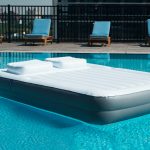Imagine a scorching summer day, with the sun beating down on you as you lounge by the pool. You reach for your go-to pool float, ready to bask in its comfortable embrace. But have you ever stopped to consider the potential dangers of that seemingly innocent inflatable?
While pool floats may appear harmless, they can actually pose serious safety risks if not used correctly. From drowning incidents to injuries caused by faulty design, there are crucial factors to keep in mind when selecting and utilizing a pool float.
With a plethora of options available on the market, it’s essential to know what to look for in a safe and reliable pool float. In this blog post, we’ll take a deep dive into the world of pool floats and explore everything you need to know about their safety.
From expert tips on choosing the right float to guidelines for proper usage, we’ve got you covered.
So, before you take the plunge with your trusted float, ensure that you’re well-informed and equipped for a secure and enjoyable experience by reading on.
Are pool floats dangerous or safe to use?
Contents
Pool floats can be both safe and dangerous, depending on how they are used. Here are some potential risks associated with pool floats:
- Drowning Risk: Pool floats are not designed to be life-saving devices. If a person falls off a float and is unable to swim, they could drown. Children and non-swimmers should be supervised closely when using pool floats.
- Entrapment Risk: Pool floats can sometimes get tangled around a person’s neck or limbs, leading to entrapment. Inflatable floats that do not have a headrest or safety features designed to prevent this are particularly risky.
- Chemical Exposure Risk: Some pool floats are made with materials that can release harmful chemicals into the water. These chemicals can irritate the skin and eyes, and in some cases, may even be toxic.
- Puncture Risk: Pool floats can be punctured by sharp objects in the pool, such as rocks, toys, or pool steps. A punctured float can deflate quickly, which can cause a person to fall into the water.
- Overheating Risk: Pool floats can trap heat, leading to overheating, especially in hot weather. Individuals should take breaks from using pool floats to cool down and avoid prolonged exposure to direct sunlight.
However, pool floats can also be used safely if proper precautions are taken. Here are some tips for safe pool float use:
- Supervision: Always supervise children and non-swimmers when they are using pool floats.
- Choose Safe Floats: Opt for floats that are designed with safety features such as headrests, mesh seats, or built-in flotation aids.
- Avoid Chemical Exposure: Choose floats that are made with high-quality, non-toxic materials.
- Inspect Regularly: Check pool floats for punctures or damage before each use.
- Educate Children: Teach children how to swim safely and to never use pool floats as a substitute for a life jacket.
By following these safety tips, you can minimize the risks associated with pool float use and enjoy a fun and safe pool experience.
Don’t mistake inflatable toys for floatation devices
It is crucial to understand the potential hazards of utilizing inflatable toys as floatation devices in pools. These dangers involve deflation or puncturing, instability, entrapment, an increased risk of sunburn and heatstroke, and possible accidents. As a parent, it is essential to take the necessary precautions to ensure your children’s safety while they are enjoying their pool floats.

One of the primary risks of using inflatable toys as floatation devices is deflation or puncturing. When weight is added to the air in the toy, it can become compressed, resulting in a limit to how much weight it can support. This limitation can lead to deflation or puncturing of the toy, causing it to lose its ability to float and potentially putting your child at risk of drowning.
Moreover, inflatable toys often lack stability, making them prone to tipping over and causing accidents. This risk increases when multiple individuals sit on the same float, as the weight distribution becomes uneven and can cause the toy to capsize.
In addition to these risks, there is also a potential for entrapment in inflatable toys. Children can easily become trapped in the toy’s deflated sections or between two connected toys, posing significant danger if they are unable to free themselves.
Furthermore, spending extended periods on pool floats can increase the risk of sunburn and heatstroke for children. The lack of shade and prolonged exposure to direct sunlight can cause severe sunburns or even heatstroke, leading to serious health complications.
Lastly, collisions and accidents are also possible when using inflatable toys as floatation devices. With multiple individuals using different pool floats in a small pool area, accidents are bound to happen if proper precautions are not taken.
Pool floats give a false sense of security for both parents and kids.

This can be perilous, as pool floats are not designed to prevent drowning and should not be used as a substitute for life jackets or proper swimming skills. In fact, relying on pool floats can increase the risk of accidents and drowning due to a lack of supervision and proper precautions.
One of the primary reasons pool floats create a false sense of security is their susceptibility to punctures or deflation, leaving children vulnerable in the water. Inflatable floats, such as tubes and rafts, can also tip over easily, causing children to fall off and potentially become trapped underneath. This can be especially hazardous if a child does not know how to swim or is not being closely monitored.
Moreover, pool floats do not teach children essential swimming skills, which are crucial for their safety in the water. By depending on pool floats, children may become overly confident in their swimming abilities and engage in risky behaviors, putting themselves at greater risk of drowning. Parents may also become distracted while their children are using pool floats, leading to accidents and injuries.
It is critical for parents to regularly inspect and clean pool floats to ensure they are safe to use. This includes checking for any holes or tears and properly inflating the float before each use.
When not in use, pool floats should be stored securely to prevent accidents and maintain their condition.
Pool floats give kids bad swimming posture
There are numerous potential hazards associated with utilizing pool floats for young children’s swimming posture.
These incorporate incorrect positioning of the head and neck, impeding their ability to learn how to swim correctly, a lack of supervision, and using floats that are not suitable for their age or size.
These dangers can result in accidents and injuries, making it crucial for parents to be aware and take necessary precautions. For a summary of these potential risks, please refer to the table below.
| Hazard | Description |
| Improper posture | The use of pool floats can cause young children to slouch or lean back, leading to incorrect positioning of the head and neck. |
| Hinders swimming progress | The lack of support for a child’s legs in a pool float can make it challenging for them to kick and propel themselves forward, hampering their progress in learning how to swim. |
| Lack of supervision | Children can easily slip out of a float or tip over if they move around too much, emphasizing the need for parents to closely supervise their child while using a pool float. |
| Unsuitable floats | Using pool floats that are not intended for a child’s age or size can be perilous and increase the risk of accidents. |
It is crucial for parents to be cognizant of these risks and take the necessary precautions when utilizing pool floats for their young children. This includes selecting appropriate floats for their child’s age and size, closely supervising them while using the float, and teaching them proper swimming techniques.
Safety tips while using pool floats
As you enjoy a day by the pool, it’s important to keep safety in mind when using pool floats. To prevent accidents, make sure to properly inflate the float before use and avoid deep water.
Also, always supervise children while they are using pool floats and follow weight restrictions to ensure their safety. Knowing basic water safety rules and proper swimming techniques can also greatly reduce the risk of accidents.
Once you’re done using the float, be sure to deflate it and store it properly to prevent tripping hazards and damage.
See the table below for a quick summary of these important safety tips.
| Properly inflate the float before use | Avoid deep water | Always supervise children |
| Follow weight restrictions | Educate yourself on water safety | Properly store the float after use |
Properly inflating the float is crucial to preventing instability and potential accidents. Most pool floats are not designed for deep water use, so it’s important to avoid them to prevent tipping over and potential drowning.
Always have an adult present to supervise children while they are using pool floats, and make sure to follow weight restrictions, as each float has a specific weight limit that it can safely support.
Educating yourself on water safety and proper swimming techniques can greatly reduce the risk of accidents while enjoying your pool float.
And when you’re finished using it, don’t forget to deflate and store it properly to keep the pool area safe and tidy for others to enjoy.
Conclusion
In conclusion, while pool floats may seem like a fun and harmless addition to a day by the pool, it’s important to be aware of their potential dangers.
From deflation and instability to improper swimming posture and a lack of supervision, there are crucial factors that can turn a day of relaxation into a dangerous situation. As responsible adults, it is our duty to prioritize safety when it comes to using pool floats.
By being informed about the potential risks associated with pool floats and taking the necessary precautions, we can all enjoy a secure and enjoyable experience in the water.






